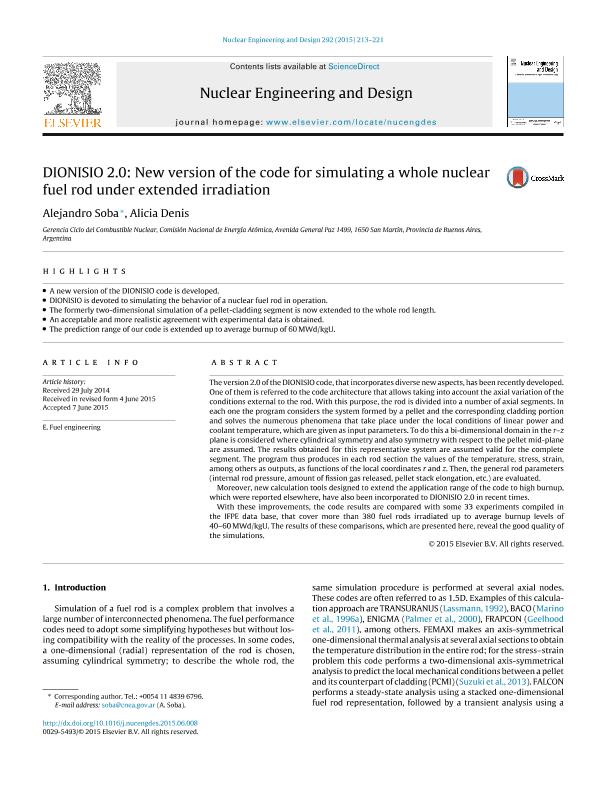Mostrar el registro sencillo del ítem
dc.contributor.author
Soba, Alejandro

dc.contributor.author
Denis, Alicia Catalina

dc.date.available
2018-05-30T18:24:32Z
dc.date.issued
2015-10
dc.identifier.citation
Soba, Alejandro; Denis, Alicia Catalina; DIONISIO 2.0: New version of the code for simulating a whole nuclear fuel rod under extended irradiation; Elsevier Science Sa; Nuclear Engineering and Design; 292; 10-2015; 213-221
dc.identifier.issn
0029-5493
dc.identifier.uri
http://hdl.handle.net/11336/46682
dc.description.abstract
The version 2.0 of the DIONISIO code, that incorporates diverse new aspects, has been recently developed. One of them is referred to the code architecture that allows taking into account the axial variation of the conditions external to the rod. With this purpose, the rod is divided into a number of axial segments. In each one the program considers the system formed by a pellet and the corresponding cladding portion and solves the numerous phenomena that take place under the local conditions of linear power and coolant temperature, which are given as input parameters. To do this a bi-dimensional domain in the r-z plane is considered where cylindrical symmetry and also symmetry with respect to the pellet mid-plane are assumed. The results obtained for this representative system are assumed valid for the complete segment. The program thus produces in each rod section the values of the temperature, stress, strain, among others as outputs, as functions of the local coordinates r and z. Then, the general rod parameters (internal rod pressure, amount of fission gas released, pellet stack elongation, etc.) are evaluated.Moreover, new calculation tools designed to extend the application range of the code to high burnup, which were reported elsewhere, have also been incorporated to DIONISIO 2.0 in recent times. With these improvements, the code results are compared with some 33 experiments compiled in the IFPE data base, that cover more than 380 fuel rods irradiated up to average burnup levels of 40-60 MWd/kgU. The results of these comparisons, which are presented here, reveal the good quality of the simulations.
dc.format
application/pdf
dc.language.iso
eng
dc.publisher
Elsevier Science Sa

dc.rights
info:eu-repo/semantics/openAccess
dc.rights.uri
https://creativecommons.org/licenses/by-nc-sa/2.5/ar/
dc.subject
Fuel Performance Simulation
dc.subject
High Burnup Structure
dc.subject
Validation Test
dc.subject.classification
Recubrimientos y Películas

dc.subject.classification
Ingeniería de los Materiales

dc.subject.classification
INGENIERÍAS Y TECNOLOGÍAS

dc.title
DIONISIO 2.0: New version of the code for simulating a whole nuclear fuel rod under extended irradiation
dc.type
info:eu-repo/semantics/article
dc.type
info:ar-repo/semantics/artículo
dc.type
info:eu-repo/semantics/publishedVersion
dc.date.updated
2018-05-23T16:31:50Z
dc.journal.volume
292
dc.journal.pagination
213-221
dc.journal.pais
Países Bajos

dc.journal.ciudad
Amsterdam
dc.description.fil
Fil: Soba, Alejandro. Comisión Nacional de Energía Atómica; Argentina. Consejo Nacional de Investigaciones Científicas y Técnicas; Argentina
dc.description.fil
Fil: Denis, Alicia Catalina. Comisión Nacional de Energía Atómica; Argentina
dc.journal.title
Nuclear Engineering and Design

dc.relation.alternativeid
info:eu-repo/semantics/altIdentifier/url/https://www.sciencedirect.com/science/article/pii/S0029549315002587
dc.relation.alternativeid
info:eu-repo/semantics/altIdentifier/doi/http://dx.doi.org/10.1016/j.nucengdes.2015.06.008
Archivos asociados
